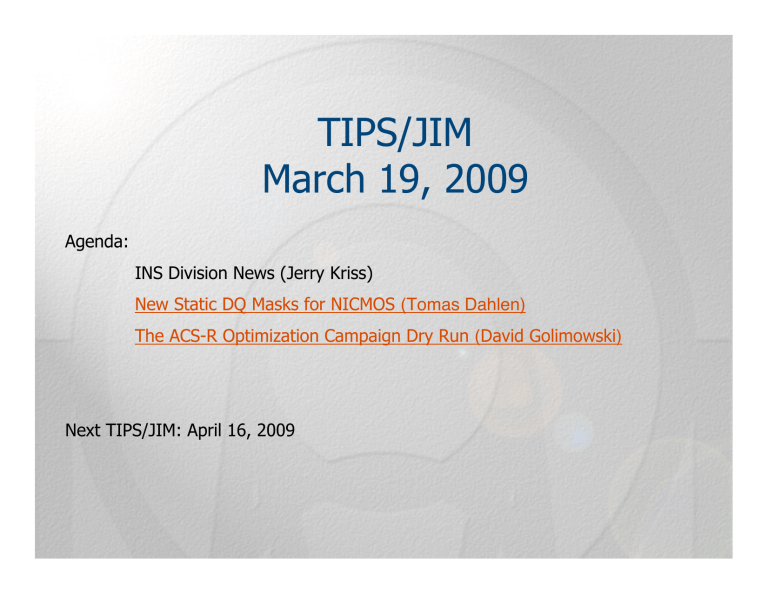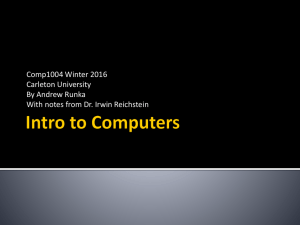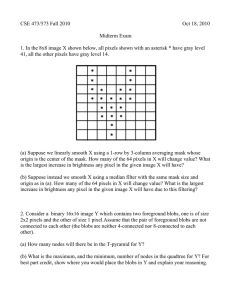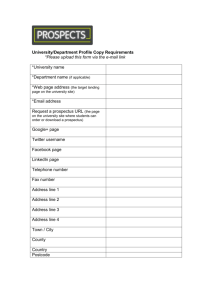TIPS/JIM March 19, 2009

TIPS/JIM
March 19, 2009
Agenda:
INS Division News (Jerry Kriss)
New Static DQ Masks for NICMOS
(Tomas Dahlen)
The ACS-R Optimization Campaign Dry Run
(
David Golimowski
)
Next TIPS/JIM: April 16, 2009
Instruments Division News
3/19/2009
•
•
•
•
•
HST news: o
Only one landing and one launch to go---SM4 is still on track for May 12, o
2009.
The ACS team has now completed their dry runs of the optimization process for the repaired ACS WFC chip plus ASIC. Dave Golimowski o will tell you more about that this morning.
The instrument teams are putting the finishing touches on their revised
Phase II proposals for SMOV activities, with plans to complete these by tomorrow.
JWST news: o
The JWST Planning and Proposal System held a very successful design review here at STScI on March 5. Congratulations to Tony Krueger’s team for an excellent job, and to the members of the WIT team who supported these activities. o
ISIM had a successful Critical Design Review last week. Congratulations to our team here supporting that activity! Margaret Meixner will give you more details on the event this morning.
Nearly all office moves within the division have been completed. The next step is recarpeting offices on the rear sides of the 3 rd and 4 th floor center section. If you have any remaining logistical problems, please contact Robin Auer.
The next INS lunch is next Thursday, March 26, in the new Boardroom, from 12:00-
1:30. A volunteer (or few) would be welcome for coordinating this!
The next TIPS meeting will be Thursday, April 16, 2009.
TIPS/JIM
March 19, 2009
Agenda:
INS Division News (Jerry Kriss)
New Static DQ Masks for NICMOS
(Tomas Dahlen)
The ACS-R Optimization Campaign Dry Run
(
David Golimowski
)
Next TIPS/JIM: April 16, 2009
New static DQ masks for NICMOS
Tomas Dahlen & Elizabeth Barker
TIPS 3/19/2009
TIPS, Mar 19, 2009 - Tomas Dahlen 1
NICMOS Data Quality (DQ) extension of calibrated images (*_cal.fits or
*_ima.fits) contains information about which pixels may be problematic and should/may be excluded when combining dithered images.
DQ
0
1
2
4
8
16
32
64
128
256
512
1024
2048
4096
8192
16384
Meaning
No known problems
Reed-Solomon decoding error in telemetry
Poor or uncertain Linearity correction
Poor or uncertain Dark correction
Poor or uncertain Flat Field correction
Pixel affected by "grot" on the detector
Defective (hot or cold) pixel
Saturated pixel
Missing data in telemetry
Bad pixel determined by calibration
Pixel contains Cosmic Ray
Pixel contains source (see Section 3.4)
Pixel has signal in 0th read
CR detected by Multidrizzle
User flag
Curvature in detector response
• Most flag values are dynamic, i.e., are set during observation/calibration.
• Static flag values are DQ=16 (“grot” affected pixels) and DQ=32 (“bad” pixels).
• Each NICMOS camera has its own static mask given in the header keyword MASKFILE.
TIPS, Mar 19, 2009 - Tomas Dahlen 2
New static DQ masks for NICMOS
• The current “post-NCS” static masks were created 2002.
• We now have a large set of calibration images obtained during NICMOS monitoring programs 2002-2008.
• We have used this data to create new static masks for the three NICMOS cameras based on better statistics.
• The temporal coverage also allows us to investigate any changes in the masks with time or detector temperature.
TIPS, Mar 19, 2009 - Tomas Dahlen 3
DQ=32 “Bad” pixels
• We use long dark exposures (>1000s) to identify “Bad” pixels as pixels with a dark current deviating from what is expected.
• Hot pixels are defined as pixels with excessive charge compared to surrounding pixels.
• Cold pixels have extremely low(/zero) dark current (i.e., “dead” pixels).
• To quantify the number of bad pixels we use the recipe in Sosey (2002,
NICMOS ISR 2002-001 “ Updating the NICMOS Static Bad Pixel Masks”).
1.
A median dark image is made using available monitoring dark data after excluding CR affected pixels
2.
A smoothed image is made and subtracted from the median image
3.
The resulting image is rescaled in units of its rms
4.
Bad pixels are defined as pixels outside 5 σ
TIPS, Mar 19, 2009 - Tomas Dahlen
Sosey (2002)
4
DQ=32 “Bad” pixels
Since we have monitored the darks continuously from 2002 to 2008, we can look for changes with time/temperature.
Old DQ=32
2002
2003
2004
2005
2006
2007
2008
All new
NIC 1
193 (0.29%)
46
49
70
69
70
66
70
88 (+0.13%)
NIC 2
656 (1.0%)
17
21
28
24
24
29
31
40 (+0.06%)
NIC 3
446 (0.68%)
16
21
28
30
29
34
36
42 (+0.06%)
Old DQ=32: Number of DQ=32 pixels in existing mask.
For each year the number of additional hot pixels is tabulated.
All new: Total number of different pixels flagged as hot during at least one year.
Black dots: number of DQ=32 pixels in existing mask.
Red dots : number of DQ=32 after adding new bad pixels 5
DQ=32 “Bad” pixels
Plots show pixels that are not flagged in existing DQ mask, but pass the criteria for being bad in this investigation.
Number of pixels that “suddenly” turn bad and can be
“saved” by using multiple DQ masks is ~5 in each camera. (In addition a few bad pixels drop below the selection with time.)
We find that having multiple DQ masks to “save” at the most a few pixels per camera is not “worthwhile” and only a single mask is created for each camera.
6
DQ=16 “grot” pixels
• The grot consists of flecks of anti-reflective paint on the detectors (that were scraped off the optical baffles between the dewars due to the expansion of the solid nitrogen in Cycle 7).
• Grot leads to areas with reduced sensitivity.
• Size of grot ranges from 25
µ m to over 100
µ m and since
NICMOS pixels are 40 µ m on a side, grot can affect regions of several pixels, as well as a fraction of a pixel.
The largest example of a grot region is the "battleship" feature in NIC 1 which affects approximately 35 pixels.
Flat-field image DQ mask 7
DQ=16 “grot” pixels
• The grot affects the incoming light onto the detectors.
• Flats are ideal to estimate the effects of grot due to their high
“uniform” counts over the whole detector.
• To quantify the grot we use the recipe in NICMOS ISR
2003-003 (Schultz et al.).
1.
We use a well sampled non-inverted flat-field (F160W filter).
2.
A smoothed flat image is subtracted from this flat.
3.
Grot pixels are defined as a pixels deviating more than 4 σ in the subtracted image (excluding bad DQ=32 pixels).
8
NIC1
NIC2
NIC3
Existing
180
243
249
New
170
123
113
DQ=16 “grot” pixels
Table: The number of grot pixels. The number found here is significantly lower than in the existing mask for nic2 and nic3.
Q: what are the characteristics of the pixels not selected using the new selection?
To investigate this we look at the relative DQE response of the flagged pixels
- this is the pixel value of a ratio image created by dividing the flat image with a smoothed flat image. “Normal” pixel has response=1.
9
NIC1
NIC2
NIC3
Existing
180
243
249
New
170
123
113
DQ=16 “grot” pixels
Relative DQE response
The new selection suggest that grot pixels have response ~< 0.8.
The pixels that are flagged in the existing mask and NOT flagged in the new selection have a fairly normal response in the range
0.8-1.2.
Existing New Existing - New
10
NIC1
NIC2
NIC3
Existing
180
243
249
New
170
123
113
DQ=16 “grot” pixels
Relative DQE response
The new selection suggest that grot pixels have response ~< 0.8.
The pixels that are flagged in the existing mask and NOT flagged in the new selection have a fairly normal response in the range
0.8-1.2.
Furthermore, the rms of the previously flagged pixels look normal
Black dots: rms of non-flagged normal pixels
Green dots: rms of previously flagged pixels
Rms look similar, green dots should be OK
We should therefore be able to “de-flag” these
Rms vs. response Previously flagged
11
DQ=16 “grot” pixels
NIC1
NIC2
NIC3
Existing New
180
243
249
170
123
113
2002
172
119
113
2008
174
139
112
Q: Does the number of grot pixels change with time?
A: No.
But there are somewhat more flagged pixels in NIC2-
2008, but these have fairly normal response 0.7-0.9.
We will not include a time dependence in the grot mask
(i.e., not create multiple masks).
FINAL SELECTION
As a final selection, we include all “4 σ pixels” from above as grot pixels, except those that have a response >0.8 and a normal signal-to-noise.
The new MASKFILEs for the post NCS era will be delivered by end of March -09.
12
Existing:
New static DQ masks for NICMOS
Summary:
NIC 1
NIC 2
NIC 3
Grot, DQ=16
Existing
180
243
249
New
163
119
96
Bad, DQ=32
Existing
193
656
446
New
281
696
448
DQ=16, grot pixels
New:
13
NIC 1 NIC 2 NIC 3
TIPS/JIM
March 19, 2009
Agenda:
INS Division News (Jerry Kriss)
New Static DQ Masks for NICMOS
(Tomas Dahlen)
The ACS-R Optimization Campaign Dry Run
(
David Golimowski
)
Next TIPS/JIM: April 16, 2009
ACS-R Optimization Campaign Dry Run:
Status Report
David Golimowski
TIPS/JIM
19 March 2009
ACS-R Flight Hardware
During SM4 (EVA-3) four elements of the ACS will be replaced or modified:
CCD Electronics Box Replacement (CEB-R) is the heart of the ACS-R hardware: it will control and read out the ACS WFC CCDs.
Schematic Diagram of CEB-R
• CEB-R features Teledyne
SIDECAR* ASIC** that permits optimization of WFC performance via adjustment of CCD clocks, biases, and pixel transmission timing
•
Built in oscilloscope mode
(O-mode) allows sensing of analog signal from each output amplifier
* System for Image Digitization,
Enhancement, Control, and Retrieval
** Application Specific Integrated Circuit
Reset Gate
DSI output B
Raw video B
Raw video A
Sample O-scope Image
ACS-R Optimization Campaign
Background:
• ACS-R Optimization Campaign (OC) in SMOV begins ~10 days after ACS-R installation and AT/FT
•
8 iterations over 24 days designed to optimize CCD read noise, dark current, CTE, full-well depth, linearity, cross-talk, and data transmission timing
•
Bias, dark, flat, EPER, and subarray images taken at different gain, CDS modes (DSI and Clamp & Sample), and readout speeds.
•
Teledyne and GSFC will analyze O-mode data; STScI will analyze image data.
Optimization Campaign Timeline
• Visits A and G (general performance tests) are executed in all iterations
• Visits B, C, D, E, and F optimize specific performance characteristics
(settling times, clock coupling, voltages) and are not executed in all iterations
•
Visits A, B, D, E, and F contain image data
• Visits B, C, and G contain O-mode data
• OC may be truncated at SMS boundary (currently between Iters 5 & 6)
ACS-R OC Dry Run
• Complicated technical and logistical issues demand Dry Run rehearsal of
OC in February/March time frame
⇒ ⇒ ⇒
Completed yesterday!
•
GSFC, Teledyne, and STScI participated
•
GSFC configured EM-3 unit (CEB-R and LVPS-R) and Build-5 WFC in ESTIF
•
Only first 4 iterations of the OC were simulated
•
All iterations were SMS driven
Dry Run dates and durations:
Iteration 1: Feb 11-13 31 hr SMS
Iteration 2: Feb 23, Mar 2-3 15 hr SMS
Iteration 3: Mar 5-6, 9-10 27 hr SMS
Iteration 4: Mar 12-13, 16-18 18 hr SMS
Dry Run Personnel
ACS-R PI:
Ed Cheng (Conceptual Analytics)
GSFC:
Olivia Lupie , Steve Arslanian, Kevin Boyce, Rick Burley, Darryl Dye, Dennis
Garland, Mike Kelly, Kathleen Mil, Barbara Scott, Beverly Serrano, Colleen
Townsley, Augustyn Waczynski, Erin Wilson
Teledyne:
Markus Loose , Raphael Ricardo
STScI:
David Golimowski , Linda Smith, Marco Sirianni (ESTEC), Carl Biagetti,
George Chapman, Marco Chiaberge, Tyler Desjardins, Norman Grogin,
Tracy Ellis, Pey-Lian Lim, Ray Lucas, Aparna Maybhate, Max Mutchler,
Anatoly Suchkov (JHU), Mike Swam, Tom Wheeler
Dry Run Results (1)
Iteration 1 : a bumpy start
• All performance and optimization tests executed to assess baseline
•
Bias & clock voltages set for WFC#4 (Flight build)
•
Problems found in several areas:
1) ESTIF: Lamp too bright (saturated data); “un-dark” biases and darks
2) SMS: No 1-min delay between changes of gain or CDS
3) OPUS: Crashes and incorrect keywords exposed outdated EUDL and
CCDTAB reference files
4) FT: Mismatched gain/offset parameters; subarray readout problem
Items 1-3 fixed for Iteration 2; FT issues now resolved
•
Despite limited data, STScI correctly assessed read noise and limited full-well depth expected for non-optimal initial voltage configuration.
Dry Run Results (2)
Iteration 2:
• General performance tests (A & G) and one optimization test (C)
•
Bias & clock voltages set for WFC#5 (flight spare)
•
Full-speed read noise 4.0-4.5 e – (DSI); 4.5-5.0 e – (C&S)
Variable striation in bias images attributed to 1/f noise from MOSFET
• Lamp now too faint; full-well exposure not obtained
Full-well depth raised to > 60K e –
•
Bias offset for half-speed DSI frames too low; ADC saturated at low end
• High frequency vertical striping in half-speed, C&S A-amp bias frames
•
Lack of hot pixels & cosmic rays preclude CTE and cross-talk tests
Iteration 2: Bias Frames
Full speed, Dual-Slope Integrator Full speed, Clamp & Sample
Iteration 2: Bias Frames
Half speed, Dual-Slope Integrator Half speed, Clamp & Sample
Dry Run Results (3)
Iteration 3:
• General performance tests (A & G) and 2 optimization tests (D and E)
•
Bias & clock voltages set for WFC#5 (flight spare)
•
Lamp brightness well matched to on-orbit cal lamp
Full-well depth measured at nominal ~80K e –
• Visit D — Bias Voltage Optimization Test:
Read noise lower, amp gains more consistent with
Δ
V
OD
=
Δ
V
DD
= +1 V
•
Visit E — Clock Voltage Optimization Test:
CTE too good for analysis software; need to improve algorithm
• Half-speed read noise 3.5-4.5 e – (DSI); 6.5-7.0 e – (C&S)
DSI: ~0.5 e – better than full-speed
C&S: significantly worse than full-speed
Iteration 3: Photon Transfer Test
• Full-well depth measured at nominal ~80K e –
•
Gain = 2.3 e – /DN
•
Excellent linearity
Dry Run Results (4)
Iteration 4:
• General performance tests (A & G) and 2 optimization tests (C and F)
•
“Up-linked” new default V
OD and V
DD for Iteration 4
•
Visit F — Science Data Transmission Optimization Test:
Find optimal size and delays of bit transfers from CEB-R to MEB
Summary and Imminent Tasks
• Dry Run was extremely useful for testing analysis software, training analysts, verifying communication and data flow, and exposing bugs and features. STScI is well prepared to tackle “The Real Thing.”
•
Need to verify and summarize analysis of all Iterations for Dry Run debrief
•
Need to revise some analysis software with newly exposed flaws
•
Rerun all data through OPUS to ensure proper keyword population
•
Insert 1-extra day of analysis for each iteration into SMOV timeline
SMSes take longer than expected to execute; data will come to us less promptly and frequently during OC; need more thinking time.
•
Ensure that successful implementation of FT is captured in EVA-3 command plan
Review of revised CP occurred yesterday; all proposed changes found to be in order and accepted.






